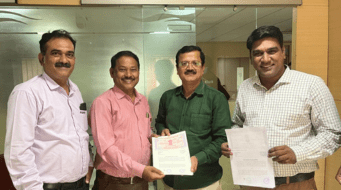Women have better knowledge and understanding on the need to adapt to a changing environment and come up with practical solutions, as they interact with their immediate environments more than men
by Abha Indurkar
In the backdrop of lush green fields, on the banks of a gentle river, I sat down to chat with a group of women. They seemed determined about their roles in tackling the climate crisis head on in Kauthe Khurd, a small hamlet in the Mula river’s basin, located in Ahmednagar district of Maharashtra.
“In our village, we have experienced the vagaries of extreme weather — erratic, uneven rainfall, longer and harsher summers, and unprecedented pest outbreaks since the last five years”, a woman in the group explained.
The experience of women in Kauthe Khurd is similar to many such villages in the semi-arid regions of the developing world. Rural populations across the globe are deeply affected by the degradation and depletion of natural resources because of climate change and accompanying natural disasters. The impact of climate change — recurring droughts, unexpected rainfall and cyclones, threaten decades of development gains and trajectories. Many of the main drivers of poverty in developing countries are intertwined with climate change.
Women are vulnerable; often first to respond

Women account for the majority of the population in the developing world living below poverty. Climate change has markedly different impacts on men and women — especially in developing countries where women gather and prepare food, collect water and fuel. Amidst the climate emergency, these tasks are more difficult. As a result, in the event of repeated natural disasters, in patriarchal societies like India, men are given priority over women, to be rescued or fed. Hence, women face greater health and safety risks.
Though women are severely affected by climate change than men, they play a major role in climate change adaptation and mitigation. Women have better knowledge and understanding on the need to adapt to a changing environment and come up with practical solutions, as they interact with their immediate environments more than men.
“We used a homemade concoction using Nirma detergent to kill the pests on corn. We saved our corn from a deadly pest outbreak last year with this innovation,” explained another woman.
Women are often the first to respond to crisis and primary decision makers at the household-level in the context of such crises.
As first responders, women can offer valuable insights to mitigate climate risks and challenges on a day-to-day level. Women can assume leadership roles even at the village-level and participate in shaping sustainable counter measures. However, they are still restricted due to lack of financial independence, time, resources, agency, training and technology, as well as limited access to political decision-making. These prevailing conditions in the developing milieu render women as an untapped resource in mitigating the climate crisis.
Policy shift

Utilising the knowledge and capacity of women in the battle against climate change is an important opportunity which will benefit us all. Though the lawmakers are yet to focus on policies keeping women at the centre of sustainable development.
Women’s issues hardly figure in the wider climate change discourse. Social implications of threats to women due to their political and economic disadvantages affect their ability to respond effectively to the challenges emerging from climate change. These challenges weaken the priorities in our climate change discourse and policy making.
Until 2008, the United Nations climate change negotiations lacked gender-related discussions. The resolution adopted in 4th session of the UN Environment Assembly, in Nairobi in March 2019, acknowledged the disproportionate burden of climate change on women and emphasised the need to encourage women’s participation and leadership in environmental decision-making and to ensure meaningful participation in global processes[1]. India’s National Action Plan on Climate Change (NAPCC), which outlines mitigation and adaptation strategies for dealing with climate change, fails to accommodate a gender dimension. It is only recently that initiatives to understand associations between gender equality and climate change response have come into focus of the action research and policy in India.
Climate Change Adaptation (CCA) programme was one such initiative undertaken by WOTR along with NABARD and the Government of Maharashtra in 2008 in the villages of Ahmednagar district. Key feature of this programme was the interventions that aimed to empower women and enable them to participate in the decision making process at home as well as at the village-level. Kauthe Khurd was one of the project villages, where women candidly spoke about their role as frontline responders to the climate crisis and benefits of being financially independent as a result of the CCA interventions.
“Through the help of the CCA interventions, we became members of Self Help Groups, and other village-level committees, which enabled us to have financial independence, agency to solve our problems and become better equipped to deal with the challenges both at household and village-level”, a woman in the group concluded.
It is imperative to engage men and women equally in climate change decision-making and action at all levels. Design, planning, financing as well as monitoring and evaluation of policies, programs and interventions, should cater to gender differential aspects of the climate crisis. There is a need for a participatory, multi-sectorial climate change gender action plan to develop comprehensive action that integrates gender concerns and build on the unique knowledge and perspectives of our women.
[1]https://www.unenvironment.org/events/un-environment-event/un-environment-assembly





